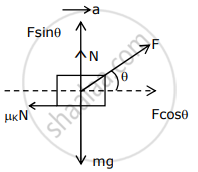Advertisements
Advertisements
Question
A block of mass m slides along a floor while a force of magnitude F is applied to it at an angle θ as shown in figure. The coefficient of kinetic friction is µK. Then, the block's acceleration 'a' is given by ______.
(g is acceleration due to gravity)

Options
`"F"/"m"costheta-mu_"k"(g-"F"/"m"sintheta)`
`"F"/"m"costheta-mu_"k"(g+"F"/"m"sintheta)`
`"F"/"m"costheta+mu_"k"(g-"F"/"m"sintheta)`
`-"F"/"m"costheta-mu_"k"(g-"F"/"m"sintheta)`
Solution
A block of mass m slides along a floor while a force of magnitude F is applied to it at an angle θ as shown in figure. The coefficient of kinetic friction is µK. Then, the block's acceleration 'a' is given by `bb("F"/"m"costheta-mu_"k"(g-"F"/"m"sintheta))`.
Explanation:
Block's free-body diagram,

For equilibrium in the vertical direction,
F sinθ + N = mg
N = mg - F sinθ ...(i)
Also, F cosθ - µkN = ma ...(ii)
Solving (i) and (ii),
a = `"F"/"m"costheta -mu_k["g"-"F"/"m"sintheta]`
